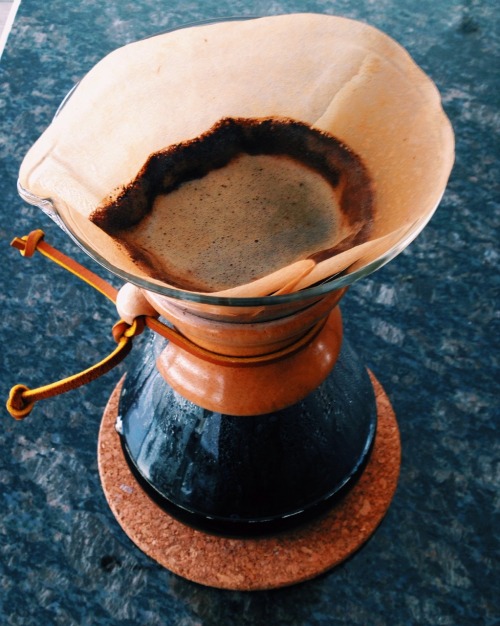I've pretty much stopped using my drip maker for my own coffee, because after doing a lot of reading about coffee, I've learned that drip machines, with very few exceptions, simply don't get the water quite hot enough to really extract the coffee. You need water that's just off the boil, about 200 degrees, so I've adopted two main methods of brewing: the French press and the pourover.
The pourover method is actually the same thing your drip machine does, only it's all done manually. You put a filter into a holder, measure your ground coffee (freshly-ground, mind you!) into the filter, and then pour the water through it. The water drips through into the receptacle below. When I make pourover coffee, here are the steps I use:
1. Fill kettle and put on stove to boil. (I'm told that if you use an electric kettle instead of the stove, the water boils a lot more quickly.)
2. While water heats, measure out and grind beans.
3. Transfer beans to filter in pourover brew basket.
4. When water boils, lift kettle from stove, hold aside for ten to fifteen seconds, and then slowly pour the water over the grounds, filling the brew basket.
5. When all the water has dripped through, repeat if necessary.
That's it. The whole process, if I'm taking my time and not acting with any urgency, might take ten minutes. It certainly doesn't take any longer to do the ritual needed to get the drip machine going, and I get better coffee for the bargain.
Here's what the process looks like:
Now, that basket is a Melitta doohickey that I got for less than ten bucks, and the filters are standard #2 cone filters. It's utilitarian and it works just fine. However, my friend on Twitter mentioned that the guy he watched used a Chemex pourover system, which is the Cadillac of pourover coffee. It looks like this:
Yes, that looks nifty. And if I had more money than I do, maybe I'd have one on the basis that they look pretty cool. But – and I say this never having actually tasted coffee brewed in the Chemex pot – I am perfectly satisfied with the flavor of the coffee that results from my cheap gizmo. I have a suspicion that my friend's coworker isn't just about having quality coffee, but about being seen executing the process using Chemex smallware.
The other brewing method I use a lot is my French press. This is more familiar-looking, even if most folks likely don't use one of these, either. You put your measured grounds at the bottom of the carafe, pour in the proper amount of water, stir, and then wait a few minutes. After the few minutes (about four) you slowly push down the plunger, clearing the grounds out of the way and then you pour off the coffee. When I use the French press, I pour my resulting coffee into a thermal carafe for hotkeeping.
What's the difference, taste-wise? Well, the French press method leaves a lot more of the oils and particulates in the coffee than does the pourover method, so for me, the result isn't very different in taste but fairly different in terms of mouth feel. French press coffee has a thicker feel, more "body" to it. I was a bit gun-shy about the French press at first, because I wondered if the coffee would lose a lot of heat just sitting there in a glass carafe for four minutes as it steeped, but it turns out that it really stays hot for that period of time. I suppose four minutes isn't long enough for four cups of water to lost that much heat once they've been brought up to a boil and I further suppose that the inch-thick layer of coffee grounds that forms up top provides some insulation against heat loss out the top of the pot.
(By the way, if you try a French press for the first time, when you press the plunger down -- press slowly. Some interesting things happen with water pressure as you push that thing down, and it can get a bit explosive if you push too quickly!)
Now, I will admit that there is one area of the whole procedure where I obstinately refuse to do things in any more of a complicated way. That's in the grinding of the beans. I still use a cheap, $20 blade-style grinder. I've been told my numerous folks whose food tastes I trust that blade grinders are awful and that you really really really have to use a burr-style grinder so as to get the uniform size of grounds that result in optimal coffee. And maybe that's even so, but I just have no desire to spend over $100 on a single-task machine for grinding coffee beans. On this point my sense of economy will go no farther! (Plus, our tiny-arsed kitchen simply does not have counter space for such an item.)
I've also heard that tossing a pinch of kosher salt into the grounds before brewing removes some of the bitterness, but...I dunno. I've tried it, but I really couldn't detect a significant enough difference to do that on a regular basis.
And there you have it: more than you wanted to know about how I make coffee!


Still love my aeropress for a really great cup of coffee. http://www.youtube.com/watch?v=48ics7oymw8
ReplyDeleteIt seems to me to be a combination of your two favorite methods. And yes with my crew of children, price is always a factor. I also covet a burr grinder. I must admit I am a Keurig man now for my frequent daytime coffees.
quality 7-8
cost 6-7 (Depends on the deal)
convenience 10
fresh anytime of day 10
Salty chiefs (really old sailors) will put eggshells in with the grounds to remove bitter oils.
ReplyDelete